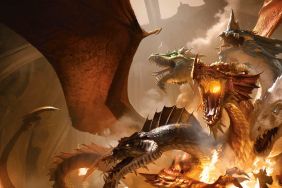At World’s End, Chaka.
Some folks just shouldn’t be allowed anywhere near success. It’s only been a year since their quirky, funky, kinda-sorta-music-strategy whoosit debut, but the Patapon (Patapons? Patapi?) are already hip-eye-deep in rhythmic doodoo again—shaking their collective, spear-chucking, tribal groove-thang for the glory of God (well… you, anyway) and taking on enemies many, many times their own size.
[image1]Time has shown that, more often than not, it’s best for a successful game not to futz too much with The Formula—and Patapon 2 is the, urhm, rule that proves the rule. As with the original game, players take the role of the more-or-less helpful Deity worshiped by the diminutive Patapon. Sailing the animated seas to the end of the world only to have their vessel hosed by a massive sea creature, they once again find themselves vogueing silhouetted poses and fighting outsized foes. While the mechanics of getting down with the Drum of Valor—via the face buttons and its different rhythm/attack/defend options—are essentially the same, the game adds new units and abilities plus a branching level scheme. Whether you’re a newcomer or a returning tribal vet, there’s something here for you.
This time around, your selected units can whip the new Hero ability on their foes by acing three separate beat-sequences. The tougher the difficulty level, the harder the required tap-accuracy. This is not only satisfying and fun, but you’re going to need these new Hero attacks to take out the bigger, more lethal, and/or annoying foes and Boss creatures (plus, anything done in real time to a groovy tribal rhythm in shadowed profile is automatically some kind of cool).
New unit types include the mage-like Mahopon, physically frail but big on the magical mega-attacks and healing; the flying Toripon, good for stand-off ranged attacks but needs to avoid anti-air strikes; the explosive-spear Yaripon; and even the Mech-style, spinning-hand Robopon, useful as a ‘brute’ unit in desperate situations where you suddenly need to take it and Tank it to the enemy—fortified or otherwise.
[image2]Patapon 2 also offers a robust selection of mini-games—entertaining action-oriented rhythm distractions, but with the advantage of unlocking new stuff by working your button-tapping magic to the rhythm.
How about the bonus of importing your old saved games from the first Patapon, seeing as how you’ve already spent so much time piling up all those funds, weapons, and resources? Not too shabby—however, in such cases, you’ll still have to grit your teeth through a series of ‘introduction’ challenges, while you wait for the full game experience to become worthy of your attentions… and it will. With extreme attitude.
Though not set up with an adequate tutorial, Patapon 2‘s Evolutionary Tree is your Pon-creation stop, where the abilities of your funky little soldiers can be honed and tweaked. It’s satisfyingly, geekily deep, if you’re into that kind of thing… but there, in fact, is the rub. It quickly turns into you having to keep straight, in your strategy/rhythm-addled brain, a dozen-plus individualized Pon’s-worth of gear, stats, etc. Deep? Indubitably. Truly useful, especially considering the crazy-frizzy amount of attention and obsession required? Maybe not so much. Still, for the hardcore—as with so many other menu-drilling tweaks in so many other games—it’s good to know it’s there.
[image3]Patapon 2 also takes the leap into multilayer (four local-wireless players, and game-sharing for your cheapo friends). All participants must cooperatively schlep a huge egg through the level to the end, eventually rhythm-tapping until the egg hatches. Until then, you’ve got a pair of players actually hauling the egg, and the other two taking escort duty. The hosting player actually gets to bring the newly-hatched reward items into his/her single-player experience (the rest of you, we appreciate your lifting and fighting moxie, and thanks for playing!) It’s great fun, but unfortunately there’s only the one mode.
While not actively newbie-hostile, Patapon 2 is really geared for players returning from the original game—they won’t miss the lack of hand-holding, and they’ll reap all kinds of benefits much sooner than newcomers. Thankfully, the designers didn’t mess anything crucial up—it’s still a cute, unique, funky, challenging and artistically-brilliant game that doesn’t merely ride its precursor’s coattails but broadens and deepens the experience, while keeping the all-important beat.
-
Lots of mission types
-
Superb audiovisuals
-
Added depth from hero abilities
-
Massive replay
-
Multiplayer!
-
Pon creation assumes player familiarity
-
Occasional sound-layer hiccups
-
New branching/level scheme gets frizzy
-
Only one multiplayer mode









